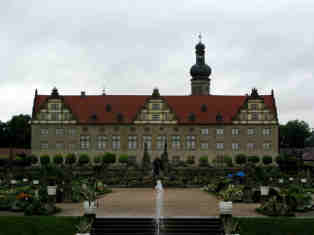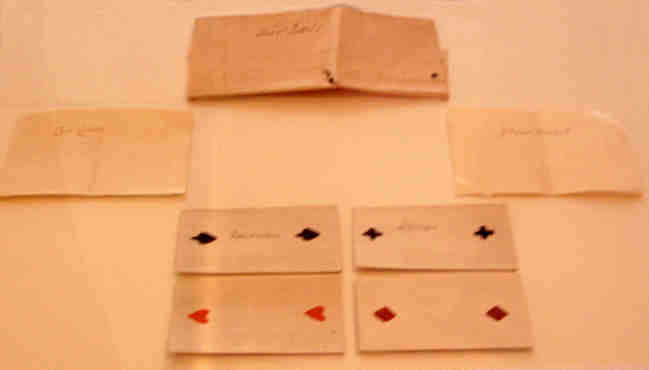****************
 |
# 26
A great holiday souvenir!
If you have
such an unusual hobby like collecting secondary used playing cards,
friends and relatives try to find you things when they are on holiday.
Last year my former bridge partner, Kuune de Boer, was traveling in
Germany. He and his wife Edith visited Weikersheim, a small town in the
Main-Tauber district. It is the location of the famous castle
"Schloss Weikersheim", build in the 12th century.
In the museum
of the castle is a show case with four playing cards. Unfortunately my
friend is a better bridge player than photographer, so the picture is
not very well focused. Like on most digital; cameras the lens focused on the glass of the show case and not on the playing cards. Still I am
very pleased with his picture and the story that comes with it. |
In the early years of
the 18th century the castle was owned by Count Johann Friedrich the First. He
had four sons. One of the sons died in a war in 1702 and an other son was, for
reasons unknown to me, not entitled to inherit the castle. So after the Count diseased
in 1702, two brothers had the right to own Weikersheim: Carl Ludwig and
Johann Friedrich II.

The property was
large and there was a second castle, named Oringen. To solve the problem of who
gets what, officers of the local government divided the land in two exactly
equal parts, each with a castle on it. The names of the castles were written on
playing cards and the two sons had to draw a card. Carl Ludwig won the
Weikersheim card and since he was a Count the castle again became the official
residential site in 1708.
I love this story!
Thank you Kuun de Boer for sharing it with me. If you find stories about playing
cards during your holidays please let me know. Maybe in September I will visit
the castle Weikersheim myself, on my way to the I.P.C.S. Convention in Ravenna,
Italy. Hope to see you there!
Gejus
Photo
of the Weikersheim playing cards by Kuun de Boer, 2006.
Photo of the castle by
Michael Fischlein, August 2004, and copied from Wikipedia.
****************

